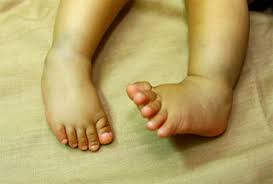Outcome Of Postero-Medial Soft Tissue Release In Congenital Talipes Equino Varus
Abstract
Background: Clubfoot is one of the most common congenital orthopaedic anomalies, first described by Hippocrates in the year 400 BC. However, its treatment still continues to challenge the skills of the paediatric orthopedic surgeon as it has a notorious tendency to relapse, irrespective of whether the foot is treated by conservative or operative means.
Material & Methods: This prospective study was conducted at our center from June 2014 to May 2016 in 39 (31 cases) congenital talipes equinovarus deformities treated by single stage posteromedial soft tissue release and the outcome assessment was done by Pirani score and Green, Lloyd- Roberts criteria.
Results: The mean age was 1.7 years. 21 were male and 10 were female. The mean pre-operative Pirani score improved from 4.8± 0.82 to 1.4± 0.86 postoperatively, which was statistically significant (p < 0.05). As per the Green Lloyd-Roberts criteria 13 (37%) feet had excellent results, 13 (37%) feet had good results and 9 (25%) feet had poor results. 6 feet had superficial infection or wound gaping and plaster sore and skin blisters were seen in 4 feet.
Conclusion: Single stage Postero-Medial Soft Tissue Release produces satisfactory results when done at appropriate age as soft tissues are more resilient to correction and the remodeling capacities of the cartilaginous bone are good.
Downloads
References
2. Kelly DM. Congential anomalies of lower extremity. In: Canale ST, Beaty JH, editors. Campbell’s Operative Orthop. 12th ed. St. Louis: Mosby Elsevier; 2008. p. 1078-100.
3. Cummings RJ, Lovell WW. Current concepts review operative treatment of congenital idiopathic clubfoot J Bone J Surg. 1988;70-A:1108-14.
4. Hegazy M, Nasef MN, Abdel-Ghani H. Results of treatment of idiopathic clubfoot in older infants using the Ponseti method: a preliminary report. J Pediatr Orthop B 2009;18:76–8.
5. Ponseti IV, Smoley EN. Congenital clubfoot: the results of treatment. J Bone Joint Surg Am 1963;45A:261–75.
6. Ponseti IV, Campos J. Observations on pathogenesis and treatment of congenital clubfoot. ClinOrthop 1972;84:50–60.
7. Colburn MW, Williams M. Evaluation of the treatment of idiopathic clubfoot by using the Ponseti method. J Foot Ankle Surg 2003;42:259–67.
8. Abbas M, Qureshi OA, Jeelani LZ, Azam Q, Khan AQ, Sabir AB. Management of congenital talipesequinovarus by ponseti technique: a clinical study. J Foot Ankle Surg 2008;47:541–5.
9. Ajmera A, Jain S, Singh A, Solanki M, Verma A. Simultaneous lateral column shortening along with differential distraction by JESS for rigid neglected club foot correction. J Paediatr Orthop (Br).2019;28:579-85.
10. Pirani S, Outerbridge H, Moran M, Sawatsky BJ. A Method of Evaluating the Virgin Clubfoot with Substantial Inter-Observer Reliability. Miami, Florida: POSNA;1995;71;99.
11. Green AD, Lloyd-Roberts GC. The results of early posterior release in resistant club feet. A long-term review. J Bone Joint Surg Br. 1985;67(4):588-93.
12. Menezes RJ, Sera R. The results of posteromedial release in clubfoot below the age of 3 years. Int J Recent Trends in Sci Technol. 2014;10(3):486-91.
13. Ramakishan D, Narsimulu SY. A 13 years’ study in surgical management of CTEV with modifications in turco’s soft tissue release in less than 1-year age group. J Evolution Med Dent Sci. 2015;4(87):15182-90.
14. Sharma AK. Modified Soft Tissue Release Procedure in Idiopathic Congenital Talipes Equinovarus. J Med Res Rev. 2015;3(6):572-8.
15. Selmani E, Selmani V. Surgical treatment of idiopathic clubfoot. Int J Sci Res. 2016;5(1):986-90.
16. Hussain SA, Khan MS, Ali MA, Shahabuddin. Modified Turco’s postero-medial release for congenital talipesequino-varus. J Ayub Med Coll Abbottabad 2008;20(3):78-80.
17. Jain S, Ajmera A, Solanki M, Verma A. Inter-observer variability in Pirani clubfoot severity scoring system between the orthopedic surgeons. Indian J Orthop. 2017;51:81-5.
18. Singh BI, Vaishnavi AJ. Modified Turco procedure for treatment of idiopathic clubfoot. Clin Orthop Relat Res. 2005;438:209-14.
19. Dobbs MB, Gurnett CA. Genetics of clubfoot. J Pediatr Orthop B 2012;21(1):7-9
20. Van Gelder JH, van Ruiten AG, Visser JD, Maathuis PG. Long-term results of the posteromedial release in the treatment of idiopathic clubfoot. J Pediatr Orthop. 2010;30(7):700-4.

The entire contents of the Orthopaedic Journal of Madhya Pradesh Chapter are protected under Indian and International copyrights. Orthopaedic Journal of Madhya Pradesh Chapter allow authors to retain the copyrights of their papers without restrictions, Authors grant the publisher the right of exclusive publication. The Journal then grants to all users a free, irrevocable, worldwide, perpetual right of access to, and a license to copy, use, distribute, perform and display the work publicly and to make and distribute derivative works in any digital medium for any reasonable non-commercial purpose, subject to proper attribution of authorship. The journal also grants the right to make numbers of printed copies for their personal non-commercial use under Creative Commons Attribution-Non-commercial share alike 4.0 International Public License.

 OAI - Open Archives Initiative
OAI - Open Archives Initiative












